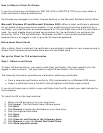
Internet
Protocol (IP)
address
The address of a computer that is attached to a network. Part of the
address designates which network the computer is on, and the other part
represents the host identification.
LAN
Local area network. A high-speed, low-error data network covering a
relatively small geographic area.
LEAP Light Extensible Authentication Protocol. A version of Extensible
Authentication Protocol (EAP). LEAP is a proprietary extensible
authentication protocol developed by Cisco, which provides a challenge-
response authentication mechanism and dynamic key assignment.
MAC A hardwired address applied at the factory. It uniquely identifies network
hardware, such as a wireless adapter, on a LAN or WAN.
Mbps Megabits-per-second. Transmission speed of 1,000,000 bits per second.
MHz Megahertz. A unit of frequency equal to 1,000,000 cycles per second.
MIC (Michael) Message integrity check (commonly called Michael).
MS-CHAP An EAP mechanism used by the client. Microsoft Challenge Authentication
Protocol (MSCHAP) Version 2, is used over an encrypted channel to enable
server validation. The challenge and response packets are sent over a non-
exposed TLS encrypted channel.
ns Nanosecond. 1 billionth (1/1,000,000,000) of a second.
OFDM Orthogonal Frequency Division Multiplexing.
PEAP Protected Extensible Authentication Protocol (PEAP) is an Internet
Engineering Task Force (IETF) draft protocol sponsored by Microsoft, Cisco,
and RSA Security. PEAP creates an encrypted tunnel similar to the tunnel
used in secure web pages (SSL). Inside the encrypted tunnel, a number of
other EAP authentication methods can be used to perform client
authentication. PEAP requires a TLS certificate on the RADIUS server, but
unlike EAP-TLS there is no requirement to have a certificate on the client.
PEAP has not been ratified by the IETF. The IETF is currently comparing
PEAP and TTLS (Tunneled TLS) to determine an authentication standard for
802.1X authentication in 802.11 wireless systems. PEAP is an
authentication type designed to take advantage of server-side EAP-
Transport Layer Security (EAP-TLS) and to support various authentication
methods, including user's passwords and one-time passwords, and Generic
Token Cards.
Peer-to-Peer
Mode
A wireless network structure that allows wireless clients to communicate
with each other without using an access point.
Power Save
mode
The state in which the radio is periodically powered down to conserve
power. When the notebook is in Power Save mode, receive packets are
stored in the access point until the wireless adapter wakes up.
Preferred
network
One of the networks that has been configured. Such networks are listed
under Preferred networks on the Wireless Networks tab of the Wireless
Configuration Utility (Windows 2000 environment) or Wireless Network
Connection Properties (Windows XP environment).


















